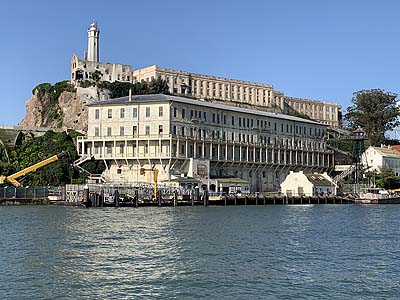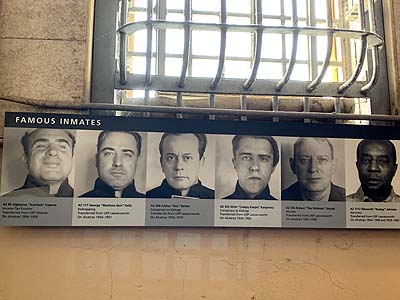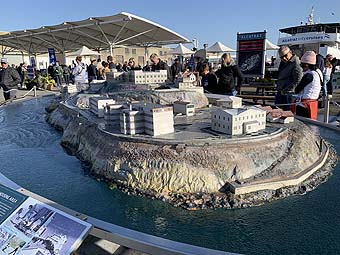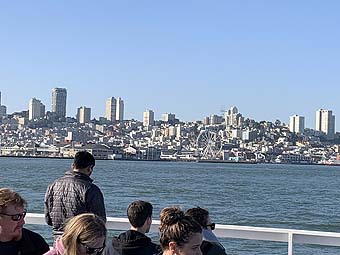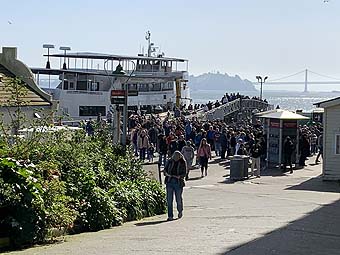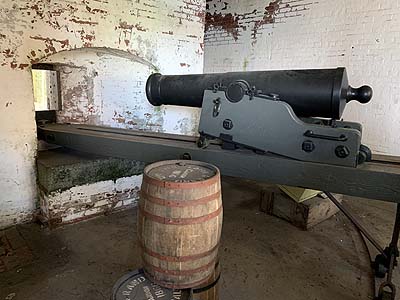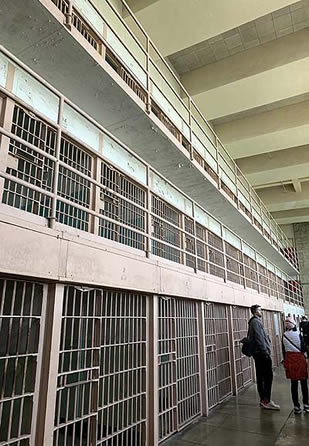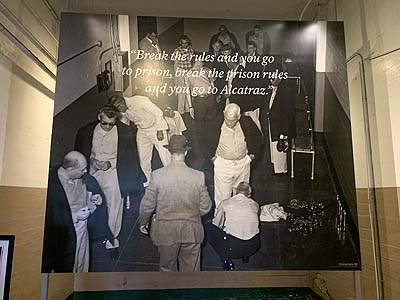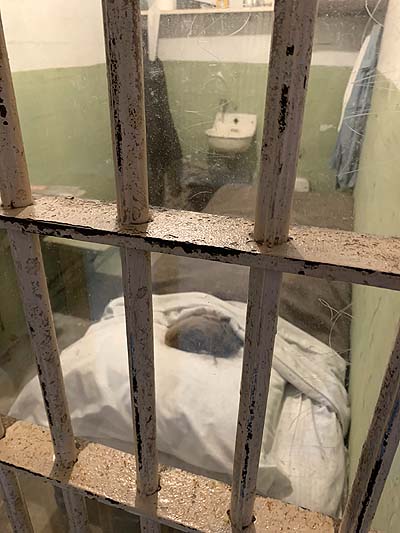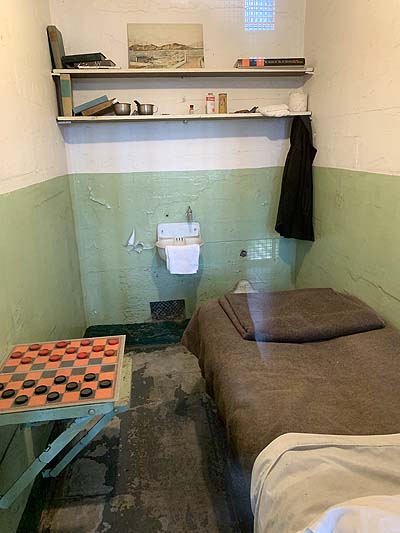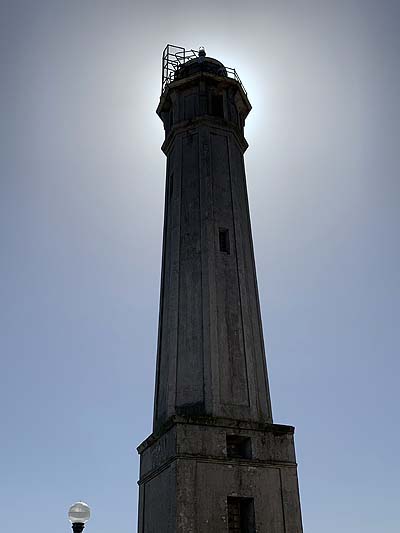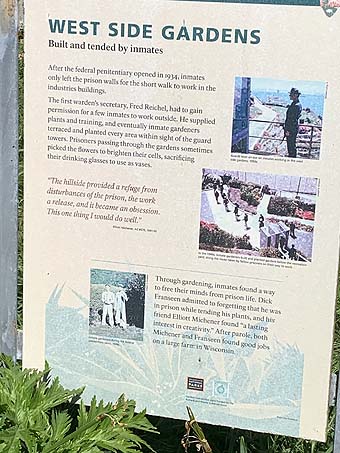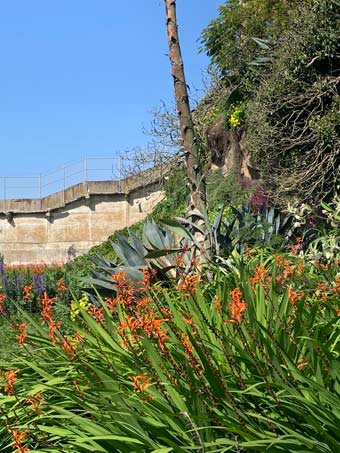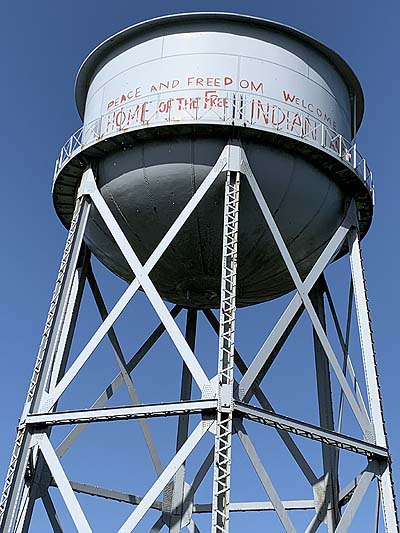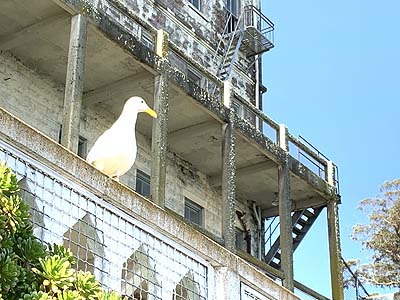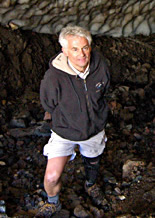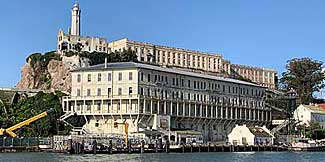 |
|
ALCATRAZ: DOING TIME AT THE ‘ROCK’ |
|||
But Not as Long as Al Capone or ‘Machine Gun’ Kelly Story and photos by Lee Juillerat |
|||
Confession – I’ve done time at Alcatraz, the maximum security federal penitentiary.
Yes, that Alcatraz, the island in the San Francisco Bay that, thanks to films like “Escape from Alcatraz” and “The Rock,” and dramatic headline-hogging escape attempts, is known as a place of mystery and fear, a place that’s known and remembered as a prison for some of the nation’s most high-profile criminals.
But unlike some of its most notorious “guests” - Al “Scarface” Capone, “Doc” Barker, Alvin “Creepy” Karpis, “George “Machine Gun” Kelly, and Robert Stroud (the “Birdman of Alcatraz”) - and others who spent years behind bars, my most recent “time” there was brief and - yes - enjoyable.
My escape to Alcatraz was a several-hour visit that began with a quick, scenic 1-1/2-mile ferry ride from Pier 33 near Fisherman’s Wharf across the bay to the prison island. Because Alcatraz is part of the Golden Gate National Recreation Area, immediately after debarking, we were greeted by a ranger who provided a brief overview of the island and its sights. Instead of immediately trooping off with that guide, friends and I meandered around the dock area, near the barracks where guards and their families once lived, and then joined another ranger for a brief interpretive walk.
There’s a wealth of information about Alcatraz. Although it’s best known for being a high security federal penitentiary in 1934, Alcatraz’s history began much earlier. It’s believed the island was occasionally visited by Ohlone and Miwok Indians but, because the island has no fresh water, it was never settled. Spanish settlers arrived about 1776, but the island was annexed by the United States in 1846. Although the island was noted on maps it was never occupied.
Later, during the 1849 Gold Rush era, when San Francisco’s population exploded from 300 to about 20,000, Alcatraz became part of a fort system built to protect the area from possible Confederate raiders. Remnants of that era, including 25-ton cannons that fired 15-inch, 440-pound cannonballs as far as three miles, are still exhibited on the island. Alcatraz later became a prison, first for Civil War era Army deserters and later for Modoc, Hopi and Apache Indians captured during the Indian wars. During World War I, the original prison, built between 1910 and 1912, also housed conscientious objectors. There’s gobs more history. But for most Alcatraz visitors, including me, the fascination is its years as a remote, solitary prison that housed some of our nation’s most famous criminals. After being transferred from military control to the Bureau of Prisons and until it closed in 1963, 1,545 men “did time” on the island.
For a sense of what life was like for those prisoners, we and hundreds of others used park-provided headsets to tour the austere cell house. A team of narrators – including four former prisoners and four former guards – provided commentary for the audio tour while directing us and keeping us moving through the cell house.
After Alcatraz was taken over by the federal Bureau of Prisons in 1934, the remodeled cell house could hold about 336 inmates in the bleak, one-man, confined 9’ x 7’cells. Inside each cell was a small sink with cold running water, a small sleeping cot and a toilet. Among the cells were 36 segregation and six solitary units. As the headset commentary explained, inmates in the D block were confined to their cells 24 hours a day, except for one weekly visit to the recreation yard.
On arriving at Alcatraz, inmates were given a copy of “Regulations for Inmates.” Among the 53 regulations was number five, which declared, “You are entitled to food, clothing, shelter and medical attention. Anything else you get is a privilege.” Another regulation - #21 - explained, “You are required to work at whatever you are told to do.” And, as a posted sign told cell block newcomers, “Break the rules and you go to prison, break the prison rules and you go to Alcatraz.”
Rule-breakers made headlines during their attempts to escape. A May 1946 headline in the San Francisco Chronicle screamed, “Alcatraz Siege! Photos of Prisoners’ Rebellion! One Guard Killed, 16 Injured” when two prisoners overpowered a guard, seized his keys and his weapons. Their escape effort eventually failed after leaving two correctional officers and three prisoners dead and many others injured.
Despite the reputation created by high-profile escape attempts and notorious prisoners, some inmates found Alcatraz an improvement over other prisons. According to the audio tour, one prisoner said that having an individual cell created a sense of privacy and reduced the chance of being sexually assaulted. According to the commentary and other reports, most prisoners said they were treated respectfully by guards and other staff and said the food was “the best within the entire prison system.” Not everyone was delighted to be caged in the tiny, stark quarters where silence was imposed. During its 30 years as a federal penitentiary, 34 men – no women were housed at Alcatraz - attempted to escape in 14 separate official attempts. Five of the men were never seen nor heard from again and are believed to have drowned. One convict, John Paul Scott, survived the swim to San Francisco but was near death when recaptured on the rocks underneath the Golden Gate Bridge. Of the breakouts, five were from the industries buildings, four from the cell house, two from garbage details, two at the dock, and one at the incinerator area.
There’s nothing inviting about the cell house, home to some of Alcatraz’s many legends. Because no noise was allowed, inmates faced a different form of torture - silence. One tormented prisoner attempted to cut off his hands with a hatchet. Other tales tell of haunting, paranormal sounds of chains being dragged along corridors and sightings of glowing red eyes and dark phantom-like figures.
But life at Alcatraz was also was reportedly enjoyed and loved by members of the correctional staff and their families, who lived in a barracks building that was converted to an apartment complex with a small market and post office. Another building was converted into a recreation hall and officer’s club that had a dance floor, gymnasium, bowling alley and soda fountain. The warden and his family lived on the island in a Mission Revival style home, with 17 large rooms and windows with sweeping across-the-bay views of San Francisco.
Something many visitors miss are the island’s verdant ornamental gardens on the western slope below the cell house. A series of signs tell the story of “The Gardener of Alcatraz,” Elliott Michener, an inmate who was originally sentenced to Leavenworth prison for counterfeiting and was later transferred to Alcatraz for being involved an escape plot. Much to his surprise, after being directed to work as a gardener, gardening became an escape from a life of crime and a post-prison job.
But Alcatraz is not now what it was then. The island’s transformation from its years as a prison is reflected by its massive population of year-round bird species, including the ubiquitous Western Gulls. At towers where armed guards once stood watch, gulls now sit. Although apparently passive and oblivious to the throngs of visitors passing by, the gulls are always on alert. They seem to have taken over as the island guardians.
Today, doing time at Alcatraz is a wonderful experience. Visiting Alcatraz Visiting Alcatraz is a popular day excursion possible through tours. Ferry boats depart from San Francisco’s Pier 33, early September to early March, 8:40 a.m. to 1:35 p.m. with return trips ending at 4:25 p.m. during those months and later from March to November. Night tours are also offered Tuesdays through Saturdays. Alcatraz Behind the Scenes Tours lasting four to five hours are also available. Bags larger than a standard backpack, 16- by 20-inches, are not allowed. Youth under 18 must be accompanied by an adult. Food and beverages, which are not sold on the island, are allowed only at picnic areas. For more information visit Alcatraz Island Tickets at www.alcatrazislandtickets.com. About the Author
|
